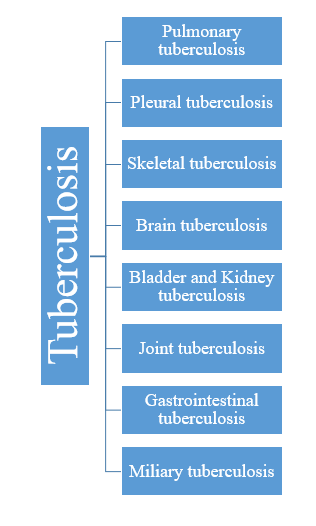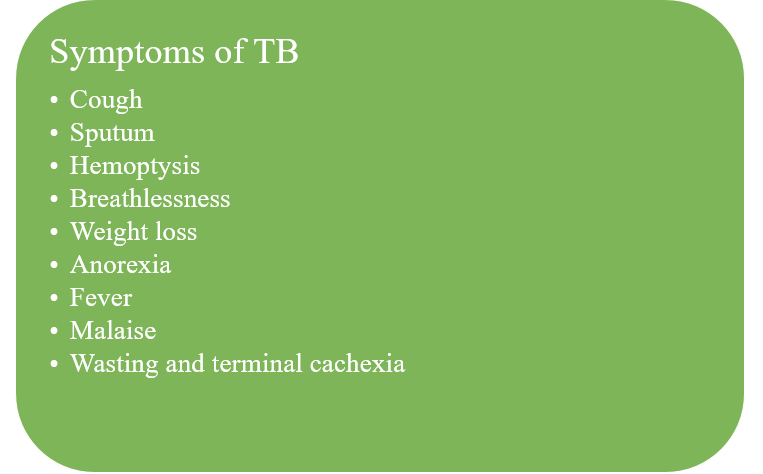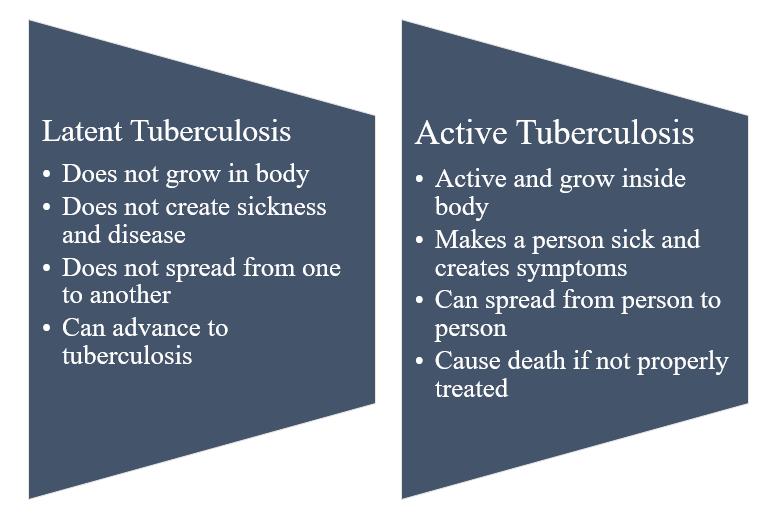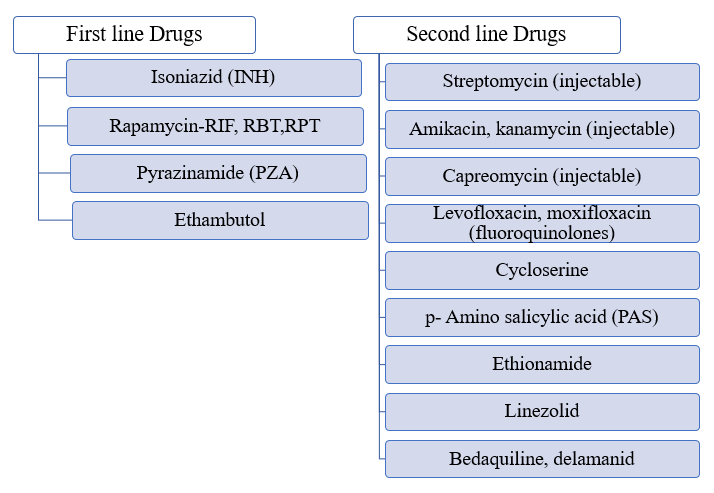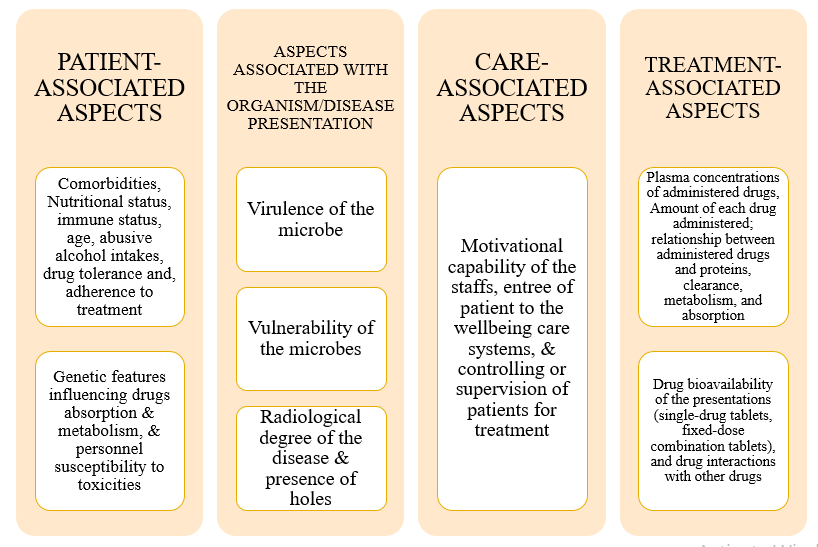Research - (2022) Future Prospects of clinical and Medical Research
Treatment of Tuberculosis by Using an Advance Approach
Singh V. K.1*, Vishal Balramnawar2, Shiva Sharma3, Pooja Mittal4 and Kavita Attri5
*Correspondence: Singh V. K., Department of General Medicine, Teerthanker Mahaveer University, Moradabad, Uttar Pradesh, India, Email:
Abstract
Tuberculosis treatment, is always a matter of concern whenever we try to approach an individual health or for the whole individual’s wellbeing. In current study states that tuberculosis is a common pulmonary disease which mainly affects lungs and in some cases affects different parts of body. It is caused by the strain of Mycobacteria generally by Mycobacterium tuberculosis and is the major reason behind the death. There are two types of tuberculosis-active and latent tuberculosis. It is mainly communicated by the coughing, sneezing, and by blood transfusion from an infected individual with the normal one. The most common symptoms associated are- coughing, fever, chilling, breathlessness and many more. Treatment for this is very lengthy and costly method with numerous side effects associated. The instant challenge to control tuberculosis is the development of a proper treatment method with less duration and can be efϔ e used by patients. The vaccine developed BCG (Bacille Calmette-Guerin), is only effective for child. In future a proper medicine can be developed by using nano materials for the targeted delivery or can be treated by using the transdermal patches for medicine delivery.
Keywords
Bacteria, Delivery, Disease, Drug, Infected, Medicine, Mycobacterium, Treatment, Tuberculosis
Introduction
Tuberculosis
Despite well-filed, well-published process of protection & cure, tuberculosis will still remain a worldwide epidemic. It is constant cause of poverty & HIV (Human Immunodeficiency Virus) disease [1]. Tuberculosis (TB), caused by Mycobacterium tuberculosis (MTB) contamination, is the most concerning health aspects [2]. According to the report of WHO, tuberculosis kill approx. 1.60 million individuals per year and about 10.0 million individuals are infected by this disease which is about every 5th people is infected by latent tuberculosis [3].
According to one report, in year 2014, approx. 9.60 million Tuberculosis patients were appeared & 1.50 million peoples die because of this disease. Furthermore, only 5.0 to 10.0 percent individuals are infected by active tuberculosis and approx. 1/3rd are affected by latent tuberculosis [4]. The pulmonary systems are mainly attacked by the bacteria, but the bacteria that cause tuberculosis can affect any part inside a body like- spines, brain, kidney, and many more. Normally every infected individuals does not get sick due to mycobacterium tuberculosis. So there are two situation for tuberculosis infection, one is latent tuberculosis and other is active tuberculosis. It may be fatal if is not treated properly
Changes in urine colour (which occur universally), curacy improvement (20%), jaundice (15%), joint pain, and gastric sensitivity (40% of patients) are the most commonly seen negative reactions to the RHZE system (in 4 percent). The most important factors related to these conditions are age (from the fourth decade of life), malnutrition (lost body weight of about 15%), history of hepatitis and coinfection with HIV, dependence on alcohol (eating alcohol daily > 80g) [10].
Some of the major tuberculosis known are discussed in Figure 1. Pulmonary tuberculosis- its common symptom is low grade fever that doesn’t passes 100 degree Fahrenheit, Pleural tuberculosis- most common symptom is breathlessness and can affect the pleura (lining of lungs), Skeletal tuberculosis- affects spinal cord and symptoms associated are weakness, fatigue and fever, Brain tuberculosis– can experience variable degree of headache and eventually leads to coma, Bladder and Kidney tuberculosis- impact on the urinary bladder which causes a situation called TB cystitis and sometimes tuberculosis affects kidney, Joint tuberculosis- pain and restricted mobility in hip and knee with low grade fever, Gastrointestinal tract tuberculosis- swallowing, poor absorption of nutrient, abdominal pain, diarrhoea, and ulcer inside the abdominal, Miliary tuberculosis- It can be life damaging tuberculosis when the larger portion of bacteria are transmitted into the blood stream and body [5].
Figure 1: Major Tuberculosis That Are Discovered A) Pulmonary Tuberculosis, B) Pleural Tuberculosis, C) Skeletal Tuberculosis, D) Brain Tuberculosis, E) Bladder and Kidney Tuberculosis, F) Joint Tuberculosis, G) Gastrointestinal Tuberculosis, H) Miliary Tuberculosis
Spreading
It is caused by the bacteria, Mycobacterium tuberculosis. Other two strains of Mycobacterium that are also responsible for spreading of tuberculosis disease are Mycobacterium africanum and Mycobacterium bovis. Tuberculosis is an infectious disease and can spread from one individual to other. The germs comes in contact with other individuals through active disease person’s coughing. Since the inhaling of the germs does not leads to active disease. Only the natural defence mechanism of one’s can define whether they get infected or not. An individual get infected only when their defence mechanism is low or the exposure time of the individual is greater.
Symptoms
Since tuberculosis are generally related to the symptoms associated with lungs because tuberculosis generally affect pulmonary area, or it may affect any areas. Tuberculosis symptoms can be better understood by the Figure 2, and are also discussed below-
Figure 2: Some of the Common Symptoms and Signs Associated With Tuberculosis.
Usual symptoms: Chills, cough, weight loss, loss of energy, fever, night sweats, loss of appetite, blood in sputum (phlegm).
Un-usual symptoms: Bad cough, coughing up blood, and chest pain, back pain or stiffness.
Types of tuberculosis
There are two different types of tuberculosis that are discussed in Figure 3:
Figure 3: Types of Tuberculosis- Latent and Active Tuberculosis.
Diagnostic method
Very first diagnostic procedure is to check swelling in lymph nodes physically and also hear the sound of lungs during breathing by the help of stethoscope. The most common most of diagnosis is skin test and blood test. The most common test for tuberculosis detection are-
Blood test: Blood tests is used to confirm latent & active tuberculosis and also tests the immunogenic response for tuberculosis bacteria.
Imaging test: It includes Chest X-ray & CT scan in which a white spot is seen inside the lungs at the plac3 where immune system has walled off tuberculosis bacteria, or it shows the lung’s impairment due to active tuberculosis.
Sputum tests: Sample of sputum is used for testing drugresistant strains of tuberculosis. Result obtained from this test takes 4-8 weeks [6].
The treatment of tuberculosis aims to curate and quickly reduce the spread of diseases. In order to be able to prevent selection of natural resistant strains (avoiding the occurrence of medical resistance during therapy), and to sterilise lesions (availability of the disease reoccurrence), these drugs should be used in a fast and rapid way [7].
Drugs used: TB is a bacterial disease that transmits from person to person in the air. TB is a disease caused by bacteria. TB generally affects the lungs, but also may influence other parts of the body, including the brain, kidneys, or backbone. However, people with TB can die if they do not receive adequate care in most cases; TB is treatable and curable. Medicinal-resistant TB often happens when bacteria become resistant to TB drugs. This means the TB bacteria can't be killed any longer. Drug resistant tuberculosis (DR tuberculosis) is transmitted as drug-resistant tuberculosis is spread. TB is transmitted by air between individuals. When a person with TB lung disease or throat cough, sneeze, talk or sing, the TB bacteria are put into the air. Nearby people will respire and become infected with these bacteria [4].
Treatment completion reports (outcome) are compulsory as well as documenting cases of tuberculosis for initiation of treatment. The care result descriptions are below. Cure is identified in the last month of treatment as a negative sputum smear or culture and bacteriologically verified at the start of the treatment in tuberculosis at least once before [8]. Tuberculosis treatment is very expensive & it’s treatment procedure is very difficult, demanding multiple medicines remedy over larger duration from 6 to 24 month [9]. Failure is characterised at or after five months of treatment as a positive sputum smear or culture. The default is characterised by an interruption of tuberculosis 30 days after the date of return (self-treatment) or 30 days after the last intake of the medication. Tuberculosis death is characterised as a death from and during treatment for tuberculosis. Another cause of death is identified as a cause other than tuberculosis death and occurs during treatment [8]. Figure 4 illustrate the difference between first line drugs and second line drug.
Figure 4: Difference between First Line and Second Line Drug.
Not everybody who has TB infection gets sick. There are thus two conditions associated with TB: latent TB infection and TB disease. In this way two conditions occur. Treatment may be applied for both latent TB infection and TB illness. TB infection may progress to TB disease without latent treatment. TB disease can be fatal if not properly treated [4].
Literature Review
Shivangi and Laxman S. Meena [11] described that Mycobacterium tuberculosis was responsible cause for tuberculosis disease which was then amplify the mortality rate for around and more than 10.0 millions of individuals. Due to the generation of tolerant medicine for tuberculosis, the therapeutic medicine delivery at the site of infection was by using nanoparticles from the very prolonged duration. Nanoparticle showed various categories of link by the usual particles inside a body. It might be utilized for controlling and targeted medicine delivery method. It could done by sequential control or could be supply measured. Glucose polymers-oriented nano materials might plays a significant part in the medicine distribution method for the situation in specific medicine delivery over a site of infection inside an individual body or inside an impair phagocyte, like due to biologically degradable nature did not have a single harmful effect inside the body & indicates slower response related to immune system. Beta 1, GUSB, CCR7, IL-2, BPI, TGFb-1, IL-13, SEC14L1 and CD4 were most common prodrugs released subsequently from the infection by the bacteria via a phagocytes which could be later on used for specific medicine distribution inside the contaminated macrophage. As per the given marker could utilized in the targeted drug delivery, and was very effective for decreasing the toxicity associated with antituberculosis medicines over the non-infected areas and can be only operative for the contaminated macrophage.
Ye-Ram Kim and Chul-Su Yang [12] explained that irrespective of any important impacts for improving the cure of tuberculosis, would always last the predominant contagious diseases across the globe due to the confinement in the present tuberculosis clinical treatment. The current efforts for development of new treating strategies for TB, recommended a targeted drug delivery in host might be helpful for the cure of tuberculosis. These approaches were named as hostdirected therapeutic (HDT) and would concentrated over host-pathogens interaction. HDT might be majorly efficient in comparison to the recently permitted tuberculosis medicines that are restricted for the need of larger period treatments & the development for the strain that show drug-resistance. HDT’s target comprises host elements like crucial enzyme’s activity, immune cell’s function, immune checkpoint & cytokine. This given study discuss the instance of introducing new method of generation & of the potentially favourable.
Jun Liu and Blair RG Gordon [13] examined the capability of Mycobacterium tuberculosis for accepting to physiologically separate host microenvironment, extending by a hollow surfaces to dangerous & unhealthy middle in granuloma, & stick for longer duration inside a host & re-energize for the reaction in order to reduce the immune scrutiny, show mostly the difficulties for an efficient management of tuberculosis. In what way Mycobacterium tuberculosis manages an articulation of gene throughout a period of infections remain basically unidentified. Given an epistasis part of Lsr2 nucleoid, was significant for determing the role of Lsr2 in case of the Mycobacterium tuberculosis infections, especially for dormant & prolonged tuberculosis infections. These understanding would help for a suitable usage of elements which may inhibit or activate the Lsr2 function.
Khaled Seidi and Rana Jahanban-Esfahlan [14] explained that Tuberculosis (TB) was an emerging unresolved health fear, like they are the major cause for any infection which would leads to death around the globe. Capability of pathogens for developing in the inactive form was a major problem for overwhelming diseases. They appeared like production of elements and could specify dormant tuberculosis was an essential step to remove the pathogens. Regarding that, numerous investigators initiated the investigation of new elements that have the capacity to inactivate the elements included for the recovery of dormant bacillus strain. A recognition of an enormously strong anti-dormant factors, the Rescue promoting Factors (Rpfs) by Micrococcus luteus, moved the focus on producing strong inhibitor of Rpf for establishing dormant TB & for avoiding repetition of sleeping pathogens. Though, in addition to the benefits of the given methodology on to the use of irritating longstanding commands for lethal antibiotic, methods which depends onto the quieting dormant tuberculosis had numerous disadvantages that might request its uses in anthropological researches. The main disadvantages of the present method was that it would camouflage the dormant tuberculosis relative to handling/eliminating them. So for that a new method was proposed which shows effectiveness for cost and eradication of all dormant & active tuberculosis within a small duration instead of attaining all threats of repetition.
Zhi Ming Tan et al. [15] described that due to the development of drug-tolerant tuberculosis, the cure of tuberculosis gets difficult. Delivery of anti-tuberculosis agent in lungs using dry powdered inhaler’s formulation appears auspicious for usage of or against immunization of TB & had produced for overwhelming the restrictions of traditional treatment like the large portion of doses compulsory, recurrent medicating & universal hostile effect. The present report concluded as the utilization of dry powdered inhalers (DPIs) formulation that were most even when compared to the solution or suspension for a distribution of whichever by drug solely or collaborative drug’s mixture for treating tuberculosis inside profound lungs with greater dosages. The benefits of dry powdered inhaler’s formulation for clinical intrusion to treat tuberculosis could be seen clearly. According to the outcomes of many reports, tuberculosis is undoubtedly observable, like improvements in preparation constancy, improved acceptance through the alveolar macrophage (AM), holds endure discharge side view & decrease harmful impacts. Though, more reports in the anticipation for high duration security side view & ability of the DPI’s preparation needs to be approved in ensuring patients ‘security & improved cure consequences.
Mohammad Nasiruddin et al. [16] explained that tuberculosis usually called as TB was among one of the death causing disease next to AIDS, originated via a bacterium known as Mycobacterium tuberculosis. The factors that are accountable for the development of MDR & XDR case of TB were- Continued cure, high pills problem, lower passivity, & rigid running schedules. Still there was only and only one vaccine is available i.e. BCG vaccine that was accessible and were unsuccessful compared to fully-grown pulmonary tuberculosis, that was the major form of known disease. Numerous different antibodies had produced for overwhelming medicine tolerant, reduces the cure routine, & uplift the passivity for handling. Thus, one requires an efficient & healthy systems for reducing technical disadvantages & recover the efficiency for medicinal therapeutics that is still the most problem causing in pharmacological expertise. Nanoparticles oriented thought had revealed substantial treatments & auspicious result for lasting contagious disease. Various kinds of nano sized carrier had estimated like favourable drug’s delivery system for numerous intake ways. Organized & continued releases of drug was one of the benefits of nanoparticles oriented anti-tuberculosis medicines above free drugs. They reduced the dose occurrence & decides the struggle of less poor passivity. Current study showed several nanotechnology- oriented therapy for tuberculosis treatment.
Discussion
In recent years, substantial advances in the strengthening of the nearly non-existent tuberculosis-treatment pipeline & re-establishing facilities for clinical trials and treatment of new tuberculosis drugs were made. In the west, refugees and poor or malnourished people suffer most from tuberculosis. Diagnosis of Mycobacterium tuberculosis and, if available, chest X-ray should be confirmed with sputum analysis. The prescribed four drug regimens should immediately treat TB and should decrease to two drugs after two months and last four months longer. TB should be treated immediately. The patient is only necessary for admission to the hospital if it is too sick or not able to handle the care at home. Smear positive patients can be deemed non-infectious after two weeks of care, smear negative patients are never infectious anyway. In a population, BCG vaccination can be selected, but should be administered to all neonates in areas of high prevalence. In developing and developed countries, an adequately resourced, wellorganized tuberculosis programme. Figure 5 illustrate the factors that influence the effectiveness of tuberculosis treatment,
Figure 5: Factors that Influence the Effectiveness of Tuberculosis Treatment.
Different types of nano carrier have calculated that they are supplying multiple intake mechanisms as favourable medicines. One of the benefits of nanoparticles-based anti-tuberculosis medicines over free medicines was organised and continuous medication releases. They reduced the dose and chose to fight against fewer passiveness’s.
Conclusion
Tuberculosis became a big problem for the population and we needed an effective way to cure people as soon as possible from this disease. Report by WHO, tuberculosis kill approximately 1.60 million peoples every year & approx. 10.0 million peoples get infected with this disease is within every 5th people around the globe are infected by latent tuberculosis. Several individuals are infected by latent or active tuberculosis, & is expected to be increase in future. The most common cause of treatment failure and medication resistance is noncompliance; it is highly difficult to predict noncompliance. The most powerful way to combat nonadherence is directly observed therapy, which facilitates therapy through intermission (less than daily) regimen. To recognise resistance and customisation, it is important to test the susceptibility of Mycobacterium tuberculosis to medication. The management of MRT is dynamic and should be conducted in specialised programmes if possible. Different levels of glucose polymers will achieve standardisation. Bio-markers containing infected macrophages assist in ensuring that targeted nano particles anti-tuberculosis. In future a novel vaccine and patches should be developed for an effective treatment of tuberculosis and the length of the treatment should be low. Majorly it is not common for all the individual so for proper awareness programs and precautionary measures is introduced in all the fields.
References
- Campbell IA, Bah-Sow O. Pulmonary tuberculosis: Diagnosis and treatment. BMJ 2006;332(7551):1194â??1197.
[Crossref], [Google Scholar], [Indexed]
- Zaman K. Tuberculosis: A global health problem. J Health Popul Nutr 2010;28(2):111â??113.
[Crossref], [Google Scholar], [Indexed]
- Donnellan S, Giardiello M. Nanomedicines towards targeting intracellular Mtb for the treatment of tuberculosis. J Interdiscip Nanomed 2019;4(3):76â??85.
[Crossref], [Google Scholar], [Indexed]
- Respir, J. TB elimination the difference between latent TB infection and TB disease. Centers dis Control Prev (2000).
[Crossref], [Google Scholar], [Indexed]
- Tandon A. [Online]. Tuberculosis: Types, causes, treatment and prevention. 2018
- Mayo Clinic. [Online]. Staff. â??Tuberculosis,â? Mayo Clinic 2021.
- Sotgiu G, Nahid P, Loddenkemper R, et al. The ERS-endorsed official ATS/CDC/IDSA clinical practice guidelines on treatment of drug-susceptible tuberculosis. Eur Respir J 2016;48(4):963â??971.
[Crossref], [Google Scholar], [Indexed]
- Brasil. Manual de recomendações para o Controle da Tuberculose no Brasil. 2019.
[Google Scholar], [Indexed]
- World Health Organization. (2018) [Online]. â??Global Tuberculosis Report 2018,â?? Relief WEB.
- Conde MB, Melo FA, Marques AM, et al. III Brazilian thoracic association guidelines on tuberculosis. Jornal Brasileiro de Pneumologia: Publicacao Oficial da Sociedade Brasileira de Pneumologia e Tisilogia 2009;35(10):1018â??1048.
[Crossref], [Google Scholar], [Indexed]
- Shivangi, Meena LS. A novel approach in treatment of tuberculosis by targeting drugs to infected macrophages using biodegradable nanoparticles. Appl Biochem Biotechnol 2018;185(3):815â??821.
[Crossref], [Google Scholar], [Indexed]
- Kim YR, Yang CS. Host-Directed Therapeutics as a Novel Approach for Tuberculosis Treatment. J Microbiol Biotechnol2017;27(9):1549â??1558.
[Crossref], [Google Scholar], [Indexed]
- Liu J, Gordon BR. Targeting the global regulator Lsr2 as a novel approach for anti-tuberculosis drug development. Expert Rev Anti Infect Ther 2012;10(9):1049â??1053.
[Crossref], [Google Scholar], [Indexed]
- Seidi K, Jahanban-Esfahlan R. A novel approach to eradicate latent TB: Based on resuscitation promoting factors. Med Hypotheses 2013;7(2):69â??74.
[Crossref], [Google Scholar], [Indexed]
- Tan ZM, Lai GP, Pandey M, et al. Novel approaches for the treatment of pulmonary tuberculosis. Pharmaceutics 2020;12(12):1196.
[Crossref], [Google Scholar], [Indexed]
- Nasiruddin M, Neyaz MK, Das S. Nanotechnology-based approach in tuberculosis treatment.
Author Info
Singh V. K.1*, Vishal Balramnawar2, Shiva Sharma3, Pooja Mittal4 and Kavita Attri5
1Department of General Medicine, Teerthanker Mahaveer University, Moradabad, Uttar Pradesh, India2Department of Pharmacy, Sanskriti University, Mathura, Uttar Pradesh, India
3School of Biomedical Engineering , Shobhit Institute of Engineering and Technology (Deemed to be Uni, India
4Department of Pharmaceutical Sciences, RIMT University, Mandi Gobindgarh, Punjab,, India
5Department of Pharmaceutics, SGT College of Pharmacy, SGT University, Gurugram , Haryana, India
Received: 02-May-2022, Manuscript No. JRMDS-22-58447; , Pre QC No. JRMDS-22-58447(PQ); Editor assigned: 04-May-2022, Pre QC No. JRMDS-22-58447(PQ); Reviewed: 13-May-2022, QC No. JRMDS-22-58447; Revised: 18-May-2022, Manuscript No. JRMDS-22-58447(R); Published: 21-Jun-2022

